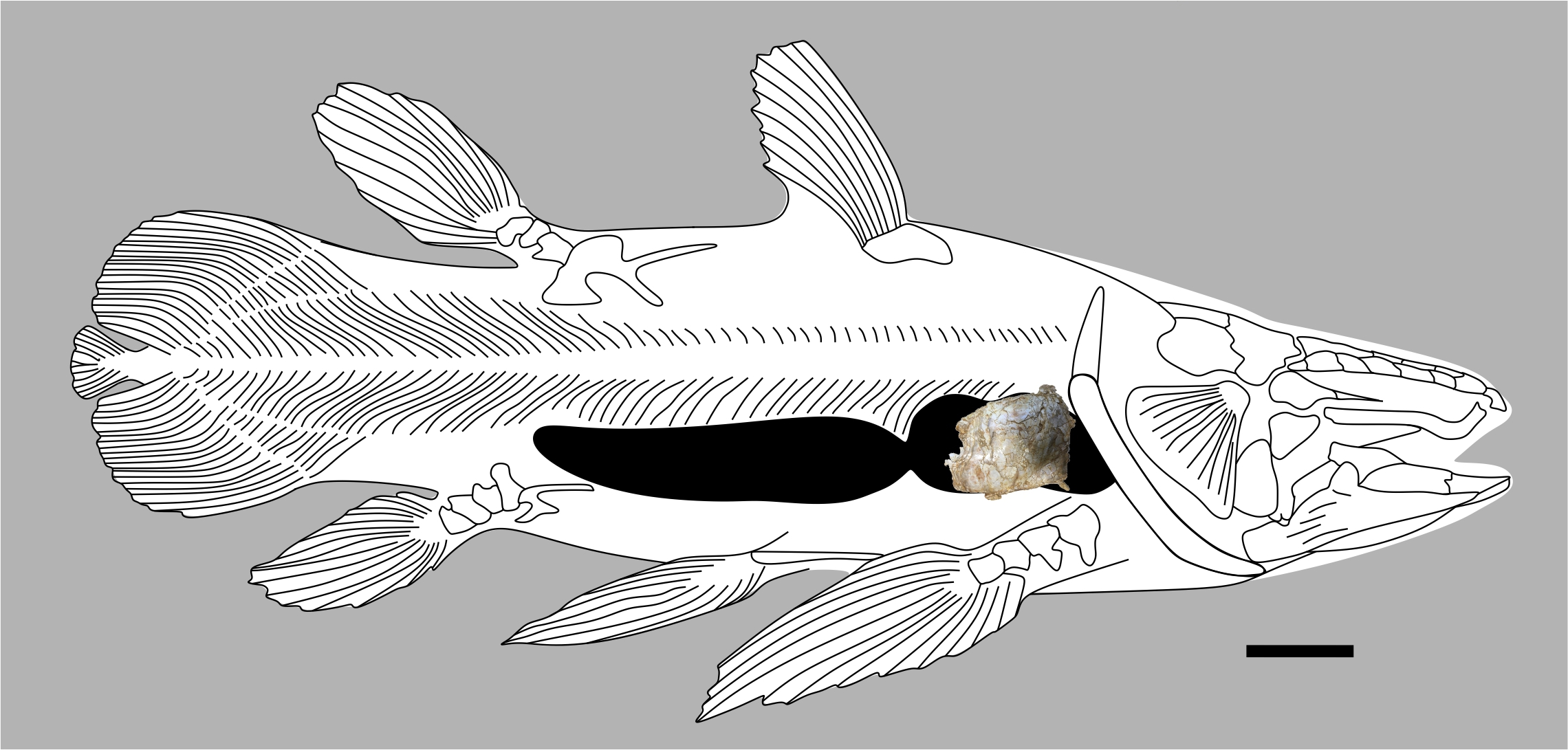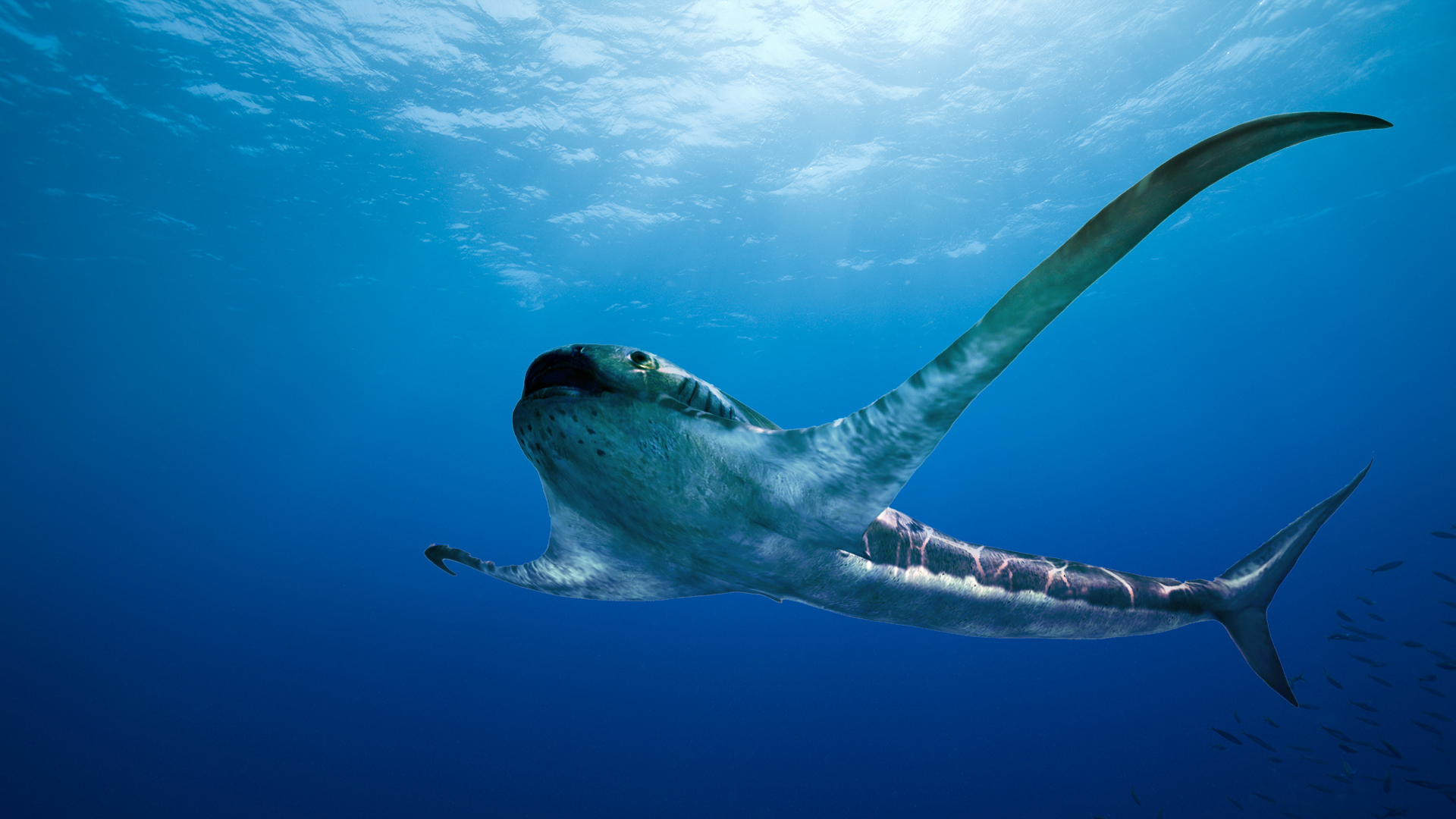10 coolest non-dinosaur fossils unearthed in 2021
The earliest multicellular lifeforms, the largest ever mammal, a fossilized lung and more.
When it comes to fossil discoveries, dinosaurs rule supreme. The extinct reptilian group grabs the headlines every time a new species is named or a possible new behavior is discovered (and rightly so). But hidden among the Stegosaurus bones and Tyrannosaurus teeth, paleontologists also find a bunch of super cool fossils from other animals that don't always get the attention they might deserve. Here is our list of the top 10 non-dinosaur fossil stories in 2021.
Parasite-infested ant in amber
In June, scientists identified a new species of extinct parasitic fungus growing out of the rectum of a 50 million-year-old ant that it killed. The entire ordeal had been fortuitously encased in amber and was perfectly preserved.
The fungus, which was named Allocordyceps baltica, can be seen throughout the unlucky ant's body, as well as protruding from its backside. A. baltica would have been very similar to the modern-day fungi in the genus Ophiocordyceps, with the main difference being the reproductive mushroom spouts: Ophiocordyceps' mushroom emerges through the victim's neck, where A. baltica comes out the back exit. Both methods likely increase the number of spores the fungus disperses, albeit in different ways.
"These types of discoveries are extremely rare," George Poinar Jr., an entomologist at Oregon State University who helped pioneer the extraction of DNA from amber, told Live Science at the time. "The amber resin contains chemicals that fixes cells and tissues and also destroys associated microbes that would normally decompose specimens."
Squid murdered mid-meal
Researchers published a study published in April describing an incredible fossil from the Jurassic period that appears to show a squid-like creature with 10 arms, known as belemnite, with its crustacean prey still clamped in its mouth. If that wasn't cool enough, bite marks in the belemnite's side suggest it too was being eaten by an unknown shark at the same time.
Get the world’s most fascinating discoveries delivered straight to your inbox.
Researchers suspect that the entwined creatures sank to the seafloor around 180 million years ago, where they fossilized together in what is now Germany. The fossil is one of only 10 belemnite fossils ever discovered. It also inspired a new term, "pabulite," which means "fossilized food leftovers that were never consumed by a predator." In this case, it applies to both the belemnite and its crustacean prey.
"Predators tend to be happy when they are eating, forgetting to pay good attention to their surroundings and potential danger," lead researcher Christian Klug, curator of the University of Zurich's Palaeontological Museum, told Live Science at the time. "That might explain why the belemnite got caught, but there is no proof for that."
Read more: Jurassic squid got murdered mid-meal, leaving this epic fossil behind
Ancient arachnid brain
In July, researchers released their findings on a rare fossilized brain from an extinct species of horseshoe crab (actually an arachnid, not a crustacean) that was found at Mazon Creek in Illinois. The brain fossil is believed to be around 310 million years old, making it one of the oldest of its kind ever discovered.
Soft tissues that make up brains are prone to rapid decay, so brain fossils are extremely rare. In this case, the brain tissue was replaced by a white mineral known as kaolinite that created an accurate mold of the brain. This was only possible due to the unique geological conditions at the site.
"This is the first and only evidence for a brain in a fossil horseshoe crab," lead author Russell Bicknell, a paleontologist at the University of New England in Maine, told Live Science at the time. The chances of finding a fossilized brain are "one in a million," he added. "Although, even then, chances are they are even rarer."
Read more: Perfectly preserved 310-million-year-old fossilized brain found
Billion-year-old fossil 'balls'
In April, researchers reported the discovery of ball-shaped fossils of multicellular organisms that are believed to be around a billion years old. The fossil "balls" are a rare evolutionary "missing link" that bridges the gap between the very first single-celled organisms and more complex multicellular life.
The tiny fossilized cell clumps, which the scientists named Bicellum brasieri, were exceptionally well-preserved in 3D, locked in nodules of phosphate minerals in Scotland. The researchers believe this site was once an ancient lake, and they suspect that the tiny organisms sank to the bottom and were preserved when they died.
"The origins of complex multicellularity and the origin of animals are considered two of the most important events in the history of life on Earth," said lead study author Charles Wellman, a professor in the Department of Animal and Plant Sciences at the University of Sheffield in England. "Our discovery sheds new light on both of these," Sheffield said in a statement.
Read more: Fossil 'balls' are 1 billion years old and could be Earth's oldest known multicellular life
Fossilized fish lung
In February, scientists announced they had discovered a new extinct species of ancient fish that was as large as a great white shark. The researchers identified the fish, which belonged to the mysterious coelacanth group, from a 66 million-year-old fossilized lung.
The unique fossil was discovered in Morocco alongside several bones from a pterosaur. Because of this association and the fossil's rounded shape, scientists initially thought it was a pterosaur skull. However, closer analysis revealed it was a fish lung. "There's only one species that has a bone structure like that, and that's the coelacanth fish," Martill said. "They actually wrap their lung in this bony sheath, it's a very unusual structure."
The new species is the largest coelacanth fish ever discovered and was found in a region where no coelacanth has ever been found before. Damage to the lung suggests that it may have been killed by a plesiosaur or mosasaur, two of the largest ocean predators at the time.
Read more: Great white-shark-sized ancient fish discovered by accident from fossilized lung
Giant hornless rhino
In June, researchers revealed they had discovered the remains of a 26.5 million-year-old giant, hornless rhino in China. The rhino, named Paraceratherium linxiaense, was 6 feet (8 meters) long with a shoulder height of 16.4 feet (5 m), and it weighed as much as 24 tons (21.7 metric tons), which is the equivalent of four African elephants. P. linxiaense is now considered one of the largest mammals ever to walk Earth.
The skull and jawbones showed that P. linxiaense had a giant, 3.7-foot-long (1.1 m) head and a small trunk, like that of a modern-day tapir. The researchers were shocked by the completeness and size of the bones, lead author Deng Tao, director and professor at the Institute of Vertebrate Paleontology and Paleoanthropology at the Chinese Academy of Sciences in Beijing, told Live Science.
The discovery also allowed the researchers to fill in crucial gaps in the family tree and geographical range of giant rhinos across Asia.
Read more: Ancient giant rhino was one of the largest mammals ever to walk Earth
Tiny 'immortal' crab
A new species of "immortal" crab entombed in amber made headlines in October. The fossil, which dates back to the Cretaceous period, is one of the earliest examples of a crab occupying a freshwater habitat and could be a "missing link" between freshwater and saltwater crabs.
The team that discovered the fossil named the newfound species Cretaspara athanata — "athanata" meaning "immortal;" "Cret-" for the Cretaceous; and "aspara" for the legendary Southeast Asian spirits of the clouds and water. C. athanata is tiny at just a fraction of an inch (2 millimeters) across, and it is closely related to modern-day true crabs.
Researchers used a type of X-ray scan to create a 3D digital model of the crab in order to study its physiology in detail. They were surprised at just how well preserved the crab was. "It's the entire animal," Luque said, "to the level of not missing a single hair on the legs or the mouth, which is mind-blowing."
Read more: Tiny 'immortal' crab entombed in amber discovered in a first of its kind
Family of spider mummies
In September, a new study revealed spiders from the now-extinct Lagonomegopidae family encased in four chunks of amber. Three of the chunks contained tiny spider hatchlings, but one exceptional piece also contained a female spider with eggs. It is believed to be the oldest example of maternal care in spiders.
The amber piece containing the spider mother clearly shows her crouched over her eggs in a protective position. It also contained the preserved silk thread that the female used to wrap her eggs together, as well as detritus from a possible nest. The three other amber chunks held a combined 84 spider hatchlings between them.
Although the finding isn't unexpected, given that many spider mothers care for their offspring nowadays, "it's lovely to have actual physical evidence through these little snapshots in the fossil record," study co-researcher Paul Selden, a distinguished professor emeritus of the Department of Geology at the University of Kansas, told Live Science.
Read more: 99 million-year-old spider mummies reveal moms cared for teeny spiderlings
Cephalopod grandaddy
In March, scientists described a new species of pill-shaped cephalopod — a group that includes octopuses, squid, cuttlefish and nautiluses — which are the oldest of their kind ever discovered.
The tiny fossils of the unnamed cephalopods date back to the early Cambrian period and are about 522 million years old. This makes them more than 30 million years younger than the previous record holder for the oldest cephalopod. They are also extremely tiny — one measured just half an inch (1.4 centimeters) tall and 0.1 inch (0.3 cm) wide.
The finding suggests "that cephalopods emerged at the very beginning of the evolution of multicellular organisms during the Cambrian explosion," study lead researcher Anne Hildenbrand, a geoscientist at the Institute of Earth Sciences at Heidelberg University in Germany, said in a statement.
Read more: 500 million-year-old fossil is the granddaddy of all cephalopods
'Winged' eagle shark
In March, a new study revealed a bizarre shark with wing-like fins and a wide, gaping mouth that soared through the seas of what is now Mexico about 93 million years ago.
The odd shark, named Aquilolamna milarcae, looks like a hybrid between the sharks we see today and mobula rays — a group that includes manta and devil rays. It was also most probably a filter feeder, like the rays, that gulped down tiny plankton-like critters. However, this shark lived more than 30 million years before mobula rays existed, according to the researchers.
This winged shark is unlike any shark alive today. "One of the most striking features of Aquilolamna is that it has very long, slender pectoral [side] fins," lead researcher Romain Vullo, a vertebrate paleontologist with the National Center for Scientific Research (CNRS) at Geosciences Rennes, in France, told Live Science. "This makes the shark wider than long," with a "wingspan" of about 6.2 feet (1.9 meters) and a total body length of about 5.4 feet (1.65 meters).
Read more: 'Winged' eagle shark soared through oceans 93 million years ago
Originally published on Live Science.

Harry is a U.K.-based senior staff writer at Live Science. He studied marine biology at the University of Exeter before training to become a journalist. He covers a wide range of topics including space exploration, planetary science, space weather, climate change, animal behavior and paleontology. His recent work on the solar maximum won "best space submission" at the 2024 Aerospace Media Awards and was shortlisted in the "top scoop" category at the NCTJ Awards for Excellence in 2023. He also writes Live Science's weekly Earth from space series.












